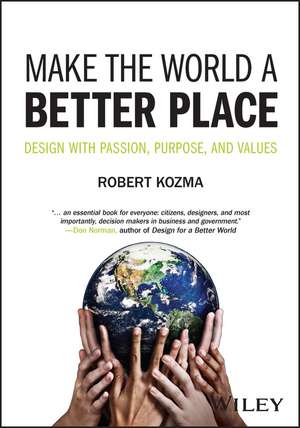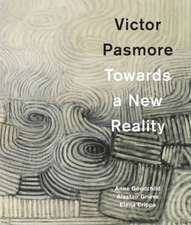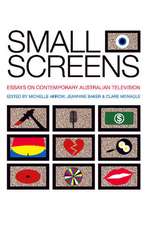Make the World a Better Place – Design with Passion, Purpose, and Values
Autor R Kozmaen Limba Engleză Paperback – 26 apr 2023
Preț: 264.30 lei
Nou
Puncte Express: 396
Preț estimativ în valută:
50.57€ • 52.94$ • 41.85£
50.57€ • 52.94$ • 41.85£
Carte disponibilă
Livrare economică 15-29 martie
Livrare express 04-08 martie pentru 36.87 lei
Preluare comenzi: 021 569.72.76
Specificații
ISBN-13: 9781394173471
ISBN-10: 1394173474
Pagini: 384
Dimensiuni: 183 x 253 x 22 mm
Greutate: 0.61 kg
Editura: Wiley
Locul publicării:Hoboken, United States
ISBN-10: 1394173474
Pagini: 384
Dimensiuni: 183 x 253 x 22 mm
Greutate: 0.61 kg
Editura: Wiley
Locul publicării:Hoboken, United States
Notă biografică
Robert Kozma, PhD, is Emeritus Principal Scientist at SRI International. During his fifty-year career, he has served as a grade school math teacher, a research scientist and professor, and a design and innovation consultant. He has counseled high tech companies, multinational organizations, and ministries of education to use technologies and methodologies to improve learning, teaching, and education.
Descriere scurtă
Cuprins
Author Bio xix Preface xxi Who Should Read This Book xxi Professional Designers and Design Students xxi Other Professionals xxi Corporate, Investment, and Foundation Officers xxii Consumers of Designs xxii Everyone Else Who Wants to Make the World a Better Place xxii How to Read This Book xxii Why I Wrote It xxiii Who Helped Me Write It xxv Part I A World by Design 1 1 Moral Imperative 3 To Design Is Human 4 Moral Responsibility of Designers 5 The Designed World 6 The best of times 7 The worst of times 9 How Has Design Failed Us? 10 Designs and users fail 11 The design process fails us 11 Designers fail us 12 Systems fail us 12 Moral Decisions and Their Consequences 13 Case Study: Boeing 737 MAX 8 14 Your Designs Might Save Us 16 References 17 2 What Is Design? 25 Everyday Design 25 Everyday Designers 26 Design as a Process 27 Purpose 28 Process 29 Outcomes 29 Impact 30 Good Designs versus Good Impacts 31 Everyday Designs and Making the World Better 32 Case Study: Chef Andrés and the World Central Kitchen 33 Designs Big, Small, and Not at All 36 References 38 3 Moral Foundations for Designing a Better World 41 The Philosophers and "The Good" 42 The Good 42 Moral Foundations for Good Design 43 Happiness not harm 43 Knowledge, reasoning, and agency 47 Equality and Justice 49 The social nature of humans 51 Self and Others 53 Self- interest 53 Rational egoism 54 The Philosophes and concern for others 55 References 57 4 Design within a System 59 Systems: Simple, Complex, and Complex Adaptive 60 Simple and complex systems 60 Complex adaptive systems 61 The Dynamics of Complex Adaptive Human Systems 62 Self-interest, reciprocity, and trust 62 Social system as a normative culture of trust and caring 65 Design to Make the System Work 65 Designs at the micro level 66 Designs at the macro level 67 Designs at the community level 68 Elinor Ostrom and Design for the Common Good 69 Case Study: Baton Rouge and "Imagine Plank Road" 69 The Appropriate Level of Complexity 73 References 74 5 Technology, Activity, and Culture 77 How to Think about Technology 78 Technology at the Micro Level: Affordances and Activity 78 Person-resource-activity model 79 Affordances and activity in the outer environment 79 Affordances and changing the inner environment 81 Embedded technology 82 Technology at the Macro Level: Culture and Impact 82 Moral Impacts of Technology and Our Designs 84 Artificial intelligence and human well-being 85 Social media, harm, and community 86 Web 3.0 and the future of community 90 CRISPR and the future of humanity 92 The moral challenge of technology 93 References 93 Part II Our Design Traditions 99 6 The Scientific Tradition 101 Design Traditions 101 Roots of the Scientific Revolution 102 Early Western science 102 The Scientific Revolution 104 Characteristics of the Scientific Tradition 104 Purpose 105 Process 106 Outcomes 107 Impact 108 Case Study: Mendelian Genetics 108 Systemic Implications of the Scientific Tradition 112 Moral Implications of the Scientific Tradition 112 References 114 7 The Technical- Analytic Tradition 117 Roots in the Industrial Revolution 117 Emergence of the Technical-Analytic Tradition 118 Maximizing efficiency 118 The consumer economy 119 Scientific research and transformative innovations 119 Characteristics of the Technical-Analytic Tradition 120 Purpose 120 Process 121 Outcomes 122 Impact 122 Case Study: Ford versus Ferrari 123 Systemic Implications of the Technical-Analytic Tradition 127 Moral Implications of the Technological-Analytic Tradition 128 References 129 8 The Human-Centered Tradition 133 Roots in the Technical-Analytic Tradition 133 Human-centered design and design thinking 134 Characteristics of the Human-Centered Approach 134 Purpose 134 Process 134 Outcomes 135 Impact 136 Case Study: Alight, Kuja Kuja, and IDEO.Org 136 Systemic Implications of the Human-Centered Approach 140 Moral Implications of the Human-Centered Approach 142 References 143 9 The Aesthetic Tradition 145 Roots in Ancient Human Expression 145 Art, design, and industry 146 Characteristics of the Aesthetic Approach 146 Purpose 147 Process 147 Outcomes 149 Impact 149 Case Study: Starry Night 149 Systemic Implications of the Aesthetic Tradition 154 Moral Implications of the Aesthetic Tradition 155 References 157 10 The Community Organization and Social Movement Tradition 159 Roots in Systemic Harm 159 The Labor Movement 159 The Civil Rights Movement 160 The Women's Movement 161 The Environmental Movement 161 The Gay Rights Movement 162 Characteristics of the Social Movement Tradition 163 Purpose 163 Process 163 Outcomes 166 Impact 166 Case Study: Black Lives Matter (BLM) 167 Systemic Implications of the Community Organization and Social Movement Tradition 172 Moral Implications of the Community Organization and Social Movement Tradition 172 Summary of Design Traditions 173 References 174 Part III Design with Passion, Purpose, and Values 177 11 Design with Passion and Purpose 179 Passion 179 Happiness 180 Empathy and compassion 180 Anger and moral outrage 180 From moral motivations to moral plans 181 Purpose 183 Purpose and design 184 Moral Reasoning and Moral Dialog 185 Moral reasoning 186 The social nature of morality 187 From moral dialog to collective action 188 Design as a Moral Dialog among Co-Creators 189 Be grounded in your own moral foundation 189 Scaffold moral discussions 190 Use these discussions to co-create designs 190 Case Study: Burning Man and Radical Inclusion 191 New Roles for Designers 196 Facilitator 196 Mentor 197 Mediator 197 Broker 197 Creating a Collaborative Culture of Moral Design 198 References 198 12 Reduce Harm and Increase Happiness 203 Values 203 Cause No Harm 203 Reduce Harm 205 Case Study: WestGate Water 206 Increase Happiness 209 Happiness as pleasure 209 Happiness as well-being 210 Happy cultures 212 Designing for Happiness 213 Case Study: Happy Cities 215 References 219 13 Advance Knowledge, Reasoning, and Agency 223 Knowledge at the Micro Level 224 Knowledge in the head 224 Knowledge in the environment 224 Knowledge and how to acquire it 225 Reasoning: What We Do with Knowledge 226 Explain 226 Make decisions and solve problems 227 Create, innovate, and design 227 The limits of knowledge and reasoning 228 Agency: How Knowledge Empowers Us 229 Metacognition 229 Self-regulated learning 230 Designing for Knowledge and Agency at the Micro Level 231 Knowledge and Institutions at the Macro Level 232 Schools and education 233 Learning in Communities 235 Knowledge Building Communities (KBCs) 235 Communities of practice (CoP) 235 Case Study: High Tech High 236 References 240 14 Promote Equality and Address Injustice 243 Equality 243 Equality by design 244 Inequality by Design 244 Native Americans 244 Enslaved Africans 246 Merit and Its Tyranny 248 Merit and morality 249 The compounding effect of inequality 250 Justice 251 What is just? 251 Equality and justice for all 253 A just society 254 Designs that Promote Equality and Address Injustice 256 Case Study: The City of Austin and Reimagining Public Safety 257 Moral Discourse to Promote Equality and Address Injustice 261 References 261 15 Build Supportive Relationships and Communities 267 Moral and Survival Foundations of Relationships 267 Relationships and Well-Being: The Micro Level 268 Emotions and relationships 268 Family 269 Married couples 270 Friends 270 Development of relationships over time 271 Relationships at the Community Level 271 Our towns, our community 272 Communities and collective action 273 Relationships at the Macro Level 274 Relationships in cities 274 Trust and social capital 275 Social capital in nations 276 Loss of Relationships and Trust 276 Loss of friends 276 Loss of interpersonal trust 277 Loss of institutional trust 277 Loss of trust and social media 278 Case Study: Braver Angels 279 Designing for Relationships and Community 282 Designs to support relationships 282 Designs to repair relationships 283 Designs to support collective action and build communities 283 References 284 Part IV Redesigning the System 289 16 The Economy, Government, and Design 291 Tragedy of the Commons 291 The Economy and Self-Interest 292 The neoliberal turn 292 Neoliberalism gets played out 294 The social impact of pure self-interest 295 Business and the loss of trust 296 The Economy and Government Control 296 Keynesian economics and government policy 296 Government control gets played out 297 The social impact of a government-controlled economy 298 Government and Collective Action 299 Public good as the purpose of government 299 Government as an institution for collective action 300 Structural limits of collective action through government 300 Political parties and collective action 301 America compromised: Corruption of the design 301 Self-interest and identity politics 302 Government and the loss of trust 303 Designs to Resolve the Tragedy 303 Business and the common good 304 Government and the common good 304 Community and the common good 306 Everyday designs and the invisible hands of a moral society 306 References 308 17 Where Do We Go from Here? 313 Which of Two Roads? 313 The road less traveled 313 The road more likely? 318 Finding a Home or Building One 322 Design as a career 322 Design where you work 323 Volunteer your time 325 Create your own design space 326 Creating a Culture of Everyday Design for a Better World 327 References 329 Index 341





















